Simple Approach for Evaluation of Abrasive Mixing Efficiency for Abrasive Waterjet Rock Cutting
Abstract
1. Introduction
2. Abrasive in the Focus
2.1. Number of Abrasive Particles in the Focus
2.2. Distance between Abrasive Particles in the Focus
3. Experimental Program
3.1. Test Cases and Setup
3.2. Abrasive and Rock Specimen
3.3. Test Procedure
4. Experimental Results and Analysis
4.1. Kinetic Energy and Rock Cutting Performance
4.2. DBP and Cutting Characteristics
5. Conclusions
- The abrasive mixing characteristics were derived based on the mixing variables, such as the WFR, the AFR, and the focus geometry. To express the complex effects of the variables, a mixing efficiency model was developed considering the chance of collision by defining the concept of the DBP, which represents the abrasive density in the focus. This model comprehensively considers the WFR, the AFR, the focus diameter and length, and the abrasive mass and diameter.
- As a result of the effects of the mixing variables, the cutting depth was experimentally obtained. It was found that using a large focus diameter or water flow rate, a higher mixing efficiency yields a greater cutting depth. The AFR affects the terminal velocity and mixing efficiency, so excessive input reduces the cutting depth. The higher the mixing efficiency, the higher the optimum AFR.
- By expressing the relationships between the experimental results and input energy as functions of the DBP, the effects of the mixing efficiency on abrasive waterjet rock cutting could be calculated. The smaller the DBP, the higher the energy required to cut a unit depth of the rock. In other words, a high energy input was required owing to the low mixing efficiency.
- The developed model demonstrated that, with a high water flow rate, the cutting efficiency was low compared to the energy input. In addition, high water flow rates indicated the optimum AFR at small DBPs. At water flow rates of over 50 mL/s, the optimum AFR was estimated to occur with a DBP of less than 0.6 mm.
- The cutting depth model was proposed based on the empirical relationship between the experimental cutting results and the mixing variables. The mixing efficiency was considered by indicating the chance of collision in terms of the DBP. The proposed model also demonstrates the effects of the mixing variables. In particular, the changes in the optimum AFR according to changes in the focus diameter are revealed. By using this model, it is possible to estimate the optimum AFR and cutting performance with minimal experimentation.
Author Contributions
Funding
Institutional Review Board Statement
Informed Consent Statement
Acknowledgments
Conflicts of Interest
Nomenclature
| D | Cutting depth (mm) |
| Focus diameter (mm) | |
| Abrasive particle diameter (mm) | |
| Kinetic energy per unit second (J/s) | |
| g | Gravitational acceleration |
| K | Resistance constant |
| Focus length (mm) | |
| Abrasive flow rate (AFR) (g/s) | |
| Optimum abrasive flow rate (g/s) | |
| Mass of single particle (g) | |
| Water flow rate (WFR) (mL/s) | |
| Total number of particles in focus | |
| Pressure of pump generated water (MPa) | |
| Operating time (i.e., time for which the abrasive is injected) (s) | |
| Time abrasive mixing in focus (s) | |
| Volume inside focus (mm3) | |
| Volume occupied by a single particle (mm3) | |
| Velocity of abrasive particle (m/s) | |
| Terminal velocity (m/s) | |
| Velocity of water (m/s) | |
| Velocity of initial water in the orifice section (m/s) | |
| Constant in the relationship between cutting depth and energy (mm) | |
| Exponent in the relationship between cutting depth and energy | |
| Unit weight of water (kg/mm3) | |
| Energy required to cut unit depth (J/mm) | |
| Momentum transfer parameter | |
| Energy required to cut one unit depth of rock (J/mm) | |
| AFR | Abrasive flow rate (g/s) |
| DBP | Distance between particles (mm) |
| SOD | Standoff distance (mm) |
| WFR | Water flow rate (mL/s) |
References
- Hlaváčová, I.M.; Sadílek, M.; Váňová, P.; Szumilo, Š.; Tyč, M. Influence of Steel Structure on Machinability by Abrasive Water Jet. Materials 2020, 13, 4424. [Google Scholar] [CrossRef]
- Karmiris-Obratański, P.; Karkalos, N.E.; Kudelski, R.; Papazoglou, E.L.; Markopoulos, A.P. On the Effect of Multiple Passes on Kerf Characteristics and Efficiency of Abrasive Waterjet Cutting. Metals 2021, 11, 74. [Google Scholar] [CrossRef]
- Korzeniowski, W.; Poborska-Młynarska, K.; Skrzypkowski, K.; Zagórski, K.; Chromik, M. Cutting Niches in Rock Salt by Means of a High-Pressure Water Jet in Order to Accelerate the Leaching of Storage Caverns for Hydrogen or Hydrocarbons. Energies 2020, 13, 1911. [Google Scholar] [CrossRef]
- Aydin, G.; Karakurt, I.; Aydiner, K. Prediction of the cut depth of granitic rocks machined by abrasive waterjet (AWJ). Rock Mech. Rock Eng. 2013, 46, 1223–1235. [Google Scholar] [CrossRef]
- Cha, Y.; Oh, T.-M.; Ahn, T.-Z.; Cho, G.-C. The state of abrasive waterjet technologies for construction in Korea. In Proceedings of the 6th International Young Geotechnical Engineer’s Conference (iYGEC6), Seoul, Korea, 6–17 September 2017; pp. 86–87. [Google Scholar]
- Hashish, M. AWJ cutting with reduced abrasive consumption. In Proceedings of the American Water Jet Conference, Houston, TX, USA, 19–21 September 2011. [Google Scholar]
- Oh, T.-M.; Cho, G.-C. Characterization of Effective Parameters in Abrasive Waterjet Rock Cutting. Rock Mech. Rock Eng. 2013, 47, 745–756. [Google Scholar] [CrossRef]
- Engin, I.C. A correlation for predicting the abrasive water jet cutting depth for natural stones. S. Afr. J. Sci. 2012, 108, 1–11. [Google Scholar] [CrossRef]
- Dani, D.N.; Shah, H.; Prajapati, H.B. An experimental investigation of abrasive water jet machining on granite. Int. J. Innov. Res. Sci Technol 2016, 3, 26–31. [Google Scholar]
- Aydin, G. Recycling of abrasives in abrasive water jet cutting with different types of granite. Arab. J. Geosci. 2014, 7, 4425–4435. [Google Scholar] [CrossRef]
- Guo, N.; Louis, H.; Meier, G.; Ohlsen, J. Recycling capacity of abrasives in abrasive water jet cutting. In Jet Cutting Technology; Springer: Berlin/Heidelberg, Germany, 1992; pp. 503–523. [Google Scholar] [CrossRef]
- Brandt, C. Abrasive suspension jets at working pressures up to 200 MPa. In Proceedings of the 12th International Conference on Jet Cutting Technology, Rouen, France, 25–27 October 1994; pp. 489–507. [Google Scholar]
- Oweinah, H. Leistungssteigerung des Hochdruckwasserstrahlschneidens durch Zugabe von Zusatzstoffen; Hanser, C., Ed.; Carl Hanser Verlag: Munich, Germany, 1990. [Google Scholar]
- Momber, A.; Kovacevic, R. Energy dissipative processes in high speed water-solid particle erosion. Asme-Publ.-Htd 1995, 321, 555–564. [Google Scholar]
- Cha, Y.; Oh, T.-M.; Cho, G.-C. Effects of Focus Geometry on the Hard Rock-Cutting Performance of an Abrasive Waterjet. Adv. Civil. Eng. 2020, 2020. [Google Scholar] [CrossRef]
- Andersson, D.; Ingvarsson, K. Design of Experiment and Evaluation of Abrasive Waterjet Cutting in Titanium Alloy Sheet; Department of Materials and Manufacturing Technology, Chalmers University of Technology: Gothenburg, Sweden, 2015. [Google Scholar]
- Hloch, S.; Gombar, M.; Valicek, J. Analysis of abrasive waterjet factors influencing the cast aluminium surface roughness. Int. J. Precis. Technol. 2007, 1. [Google Scholar] [CrossRef]
- Kechagias, J.; Petropoulos, G.; Vaxevanidis, N. Application of Taguchi design for quality characterization of abrasive water jet machining of TRIP sheet steels. Int. J. Adv. Manuf. Technol. 2011, 62, 635–643. [Google Scholar] [CrossRef]
- Momber, A.W.; Kovacevic, R. Principles of Abrasive Water Jet Machining; Springer Science & Business Media: Berlin, Germany, 2012. [Google Scholar]
- Hale, P. Multi-Modelling of Abrasive Waterjet Machining; McMaster University: Hamilton, ON, Canada, 2012. [Google Scholar]
- Labus, T.; Neusen, K.; Alberts, D.; Gores, T. Factors influencing the particle size distribution in an abrasive waterjet. J. Eng. Ind. 1991, 113, 402–411. [Google Scholar] [CrossRef]
- Hashish, M. Optimization factors in abrasive-waterjet machining. J. Eng. Ind. 1991, 113, 29–37. [Google Scholar] [CrossRef]
- Momber, A.W. Energy transfer during the mixing of air and solid particles into a high-speed waterjet: An impact-force study. Exp. Therm. Fluid Sci. 2001, 25, 31–41. [Google Scholar] [CrossRef]
- Guo, N.; Louis, H.; Meier, G. Surface structure and kerf geometry in abrasive waterjet cutting: Formation and optimization. In Proceedings of the 7th American Water Jet Conference, Seattle, DC, USA, 28–31 August 1993; pp. 1–25. [Google Scholar]
- Jegaraj, J.J.R.; Babu, N.R. A soft computing approach for controlling the quality of cut with abrasive waterjet cutting system experiencing orifice and focusing tube wear. J. Mater. Process. Technol. 2007, 185, 217–227. [Google Scholar] [CrossRef]
- Babu, M.K.; Chetty, O.K. Studies on recharging of abrasives in abrasive water jet machining. Int. J. Adv. Manuf. Technol. 2002, 19, 697–703. [Google Scholar] [CrossRef]
- Feng, Y.; Jianming, W.; Feihong, L. Numerical simulation of single particle acceleration process by SPH coupled FEM for abrasive waterjet cutting. Int. J. Adv. Manuf. Technol. 2011, 59, 193–200. [Google Scholar] [CrossRef]
- Chalmers, E. Effect of parameter selection on abrasive waterjet performance. In Proceedings of the 6th American Water Jet Conference, Houston, TX, USA, 24–27 August 1991; pp. 345–354. [Google Scholar]
- Hashish, M. Pressure effects in abrasive-waterjet (AWJ) machining. J. Eng. Mater. Technol. 1989, 111, 221–228. [Google Scholar] [CrossRef]
- Kovacevic, R.; Momber, A.; Mohen, R. Energy dissipation control in hydro-abrasive machining using quantitative acoustic emission. Int. J. Adv. Manuf. Technol. 2002, 20, 397–406. [Google Scholar] [CrossRef]
- Oh, T.-M.; Cho, G.-C. Rock cutting depth model based on kinetic energy of abrasive waterjet. Rock Mech. Rock Eng. 2016, 49, 1059–1072. [Google Scholar] [CrossRef]
- Mott, R.L.; Noor, F.M.; Aziz, A.A. Applied Fluid Mechanics; Prentice Hall: Upper Saddle River, NJ, USA, 2006. [Google Scholar]
- Henning, A.; Miles, P.; Stang, D. Efficient operation of abrasive waterjet cutting in industrial applications. In Proceedings of the WJTA-IMCA Conference and Expo, Houston, TX, USA, 19–21 September 2011. Paper A. [Google Scholar]
- Abdel-Rahman, A.A. A Closed-form Expression for an abrasive waterjet cutting model for ceramic materials. Int. J. Math. Models Methods Appl. Sci. 2011, 5, 722–729. [Google Scholar]
- Momber, A. A probabilistic model for the erosion of cement-based composites due to very high-speed hydro-abrasive flow. Wear 2016, 368, 39–44. [Google Scholar] [CrossRef]
- Roth, P.; Looser, H.; Heiniger, K.; Bühler, S. Determination of abrasive particle velocity using laser-induced fluorescence and particle tracking methods in abrasive water jets. In Proceedings of the 2005 WJTA Conference and Exposition, Houston, TX, USA, 21–23 August 2005; pp. 21–23. [Google Scholar]
- Cui, L.; An, L.; Gong, W. Effects of process parameters on the comminution capability of high pressure water jet mill. Int. J. Mineral. Process. 2006, 81, 113–121. [Google Scholar] [CrossRef]
- ASTM. D6913-04: Standard Test Methods for Particle Size Distribution (Gradation) of Soils Using Sieve Analysis; ASTM International West Conshohocken: West Conshohocken, PA, USA, 2009. [Google Scholar]
- ASTM. D422-63: Standard Test Method for Particle-Size Analysis of Soils; ASTM International West Conshohocken: West Conshohocken, PA, USA, 2007. [Google Scholar]
- ASTM. D7012–14: Standard Test Method for Compressive Strength and Elastic Moduli of Intact Rock Core Specimens under Varying States of Stress and Temperatures; ASTM International West Conshohocken: West Conshohocken, PA, USA, 2014. [Google Scholar]
- Brown, E.T. Rock Characterization Testing and Monitoring; Pergamon Press: Oxford, UK, 1981. [Google Scholar]
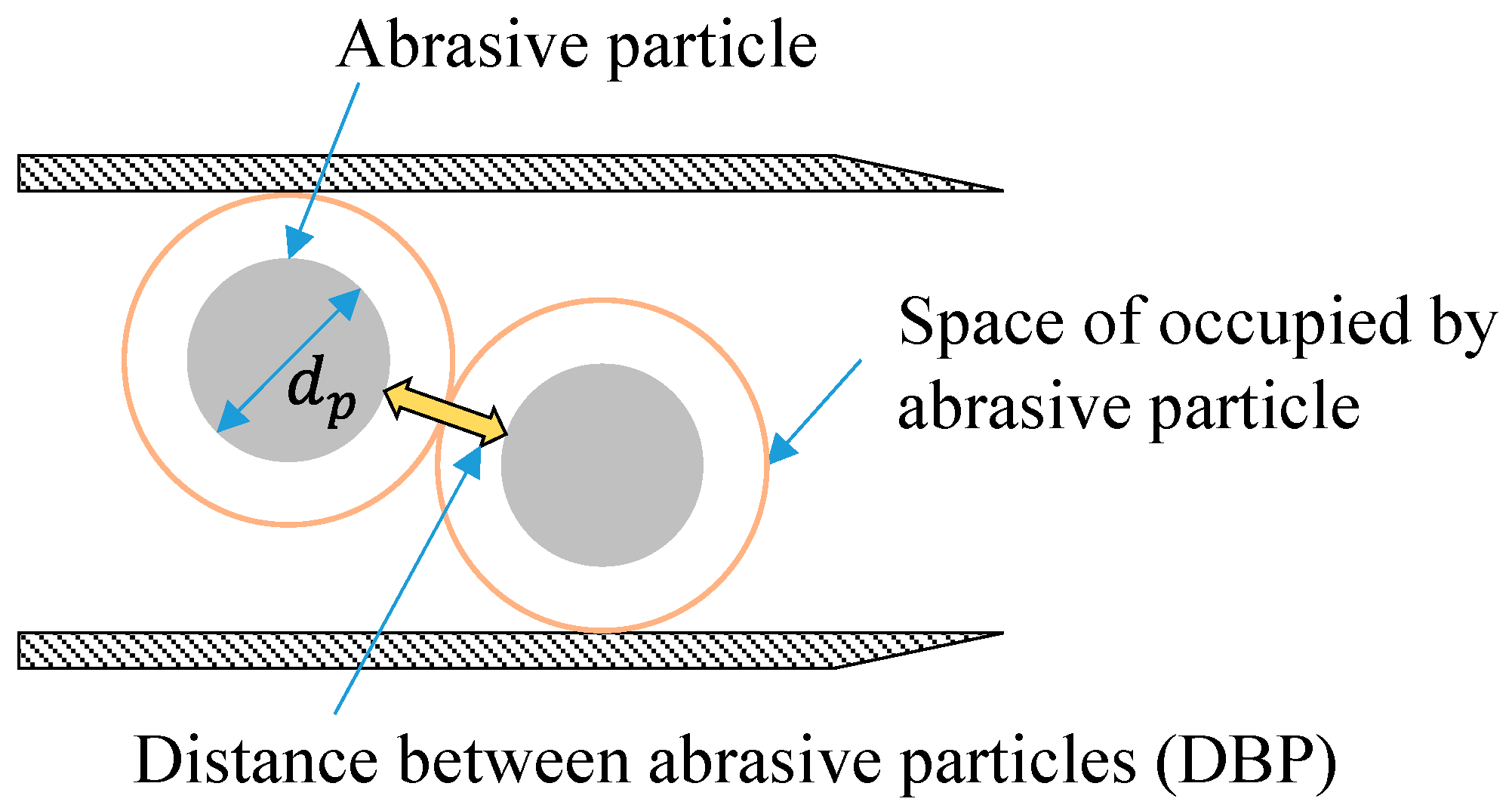

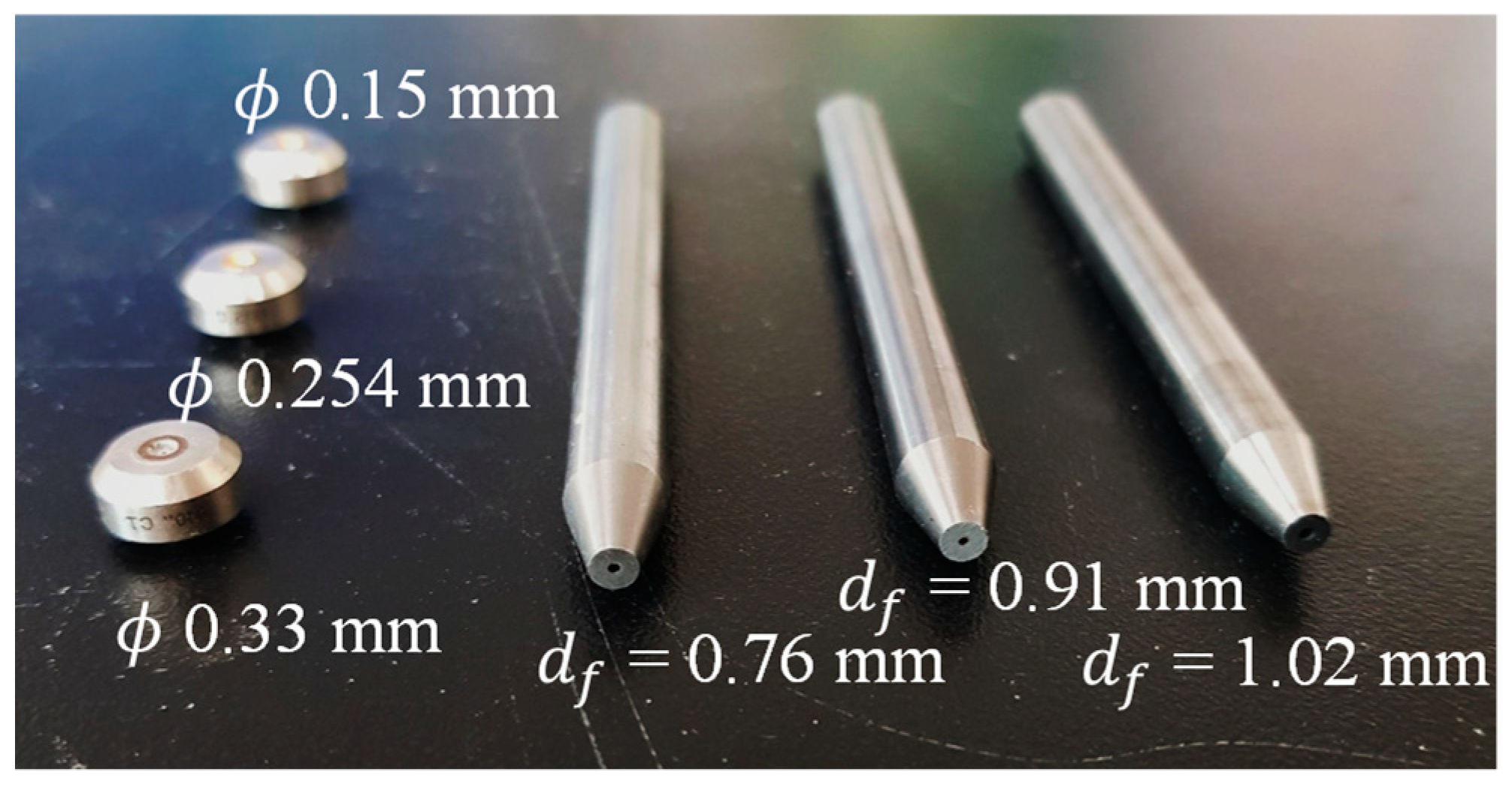
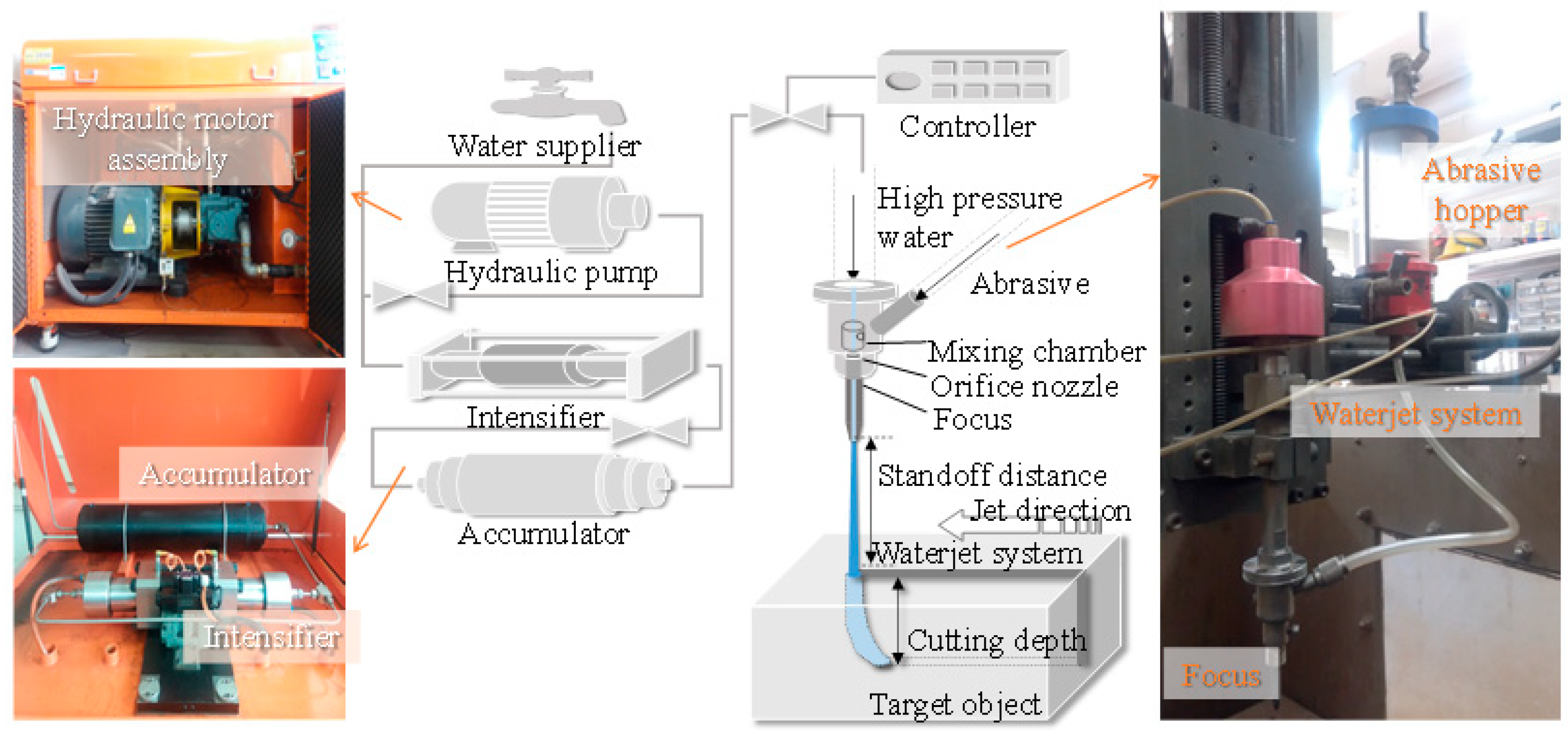

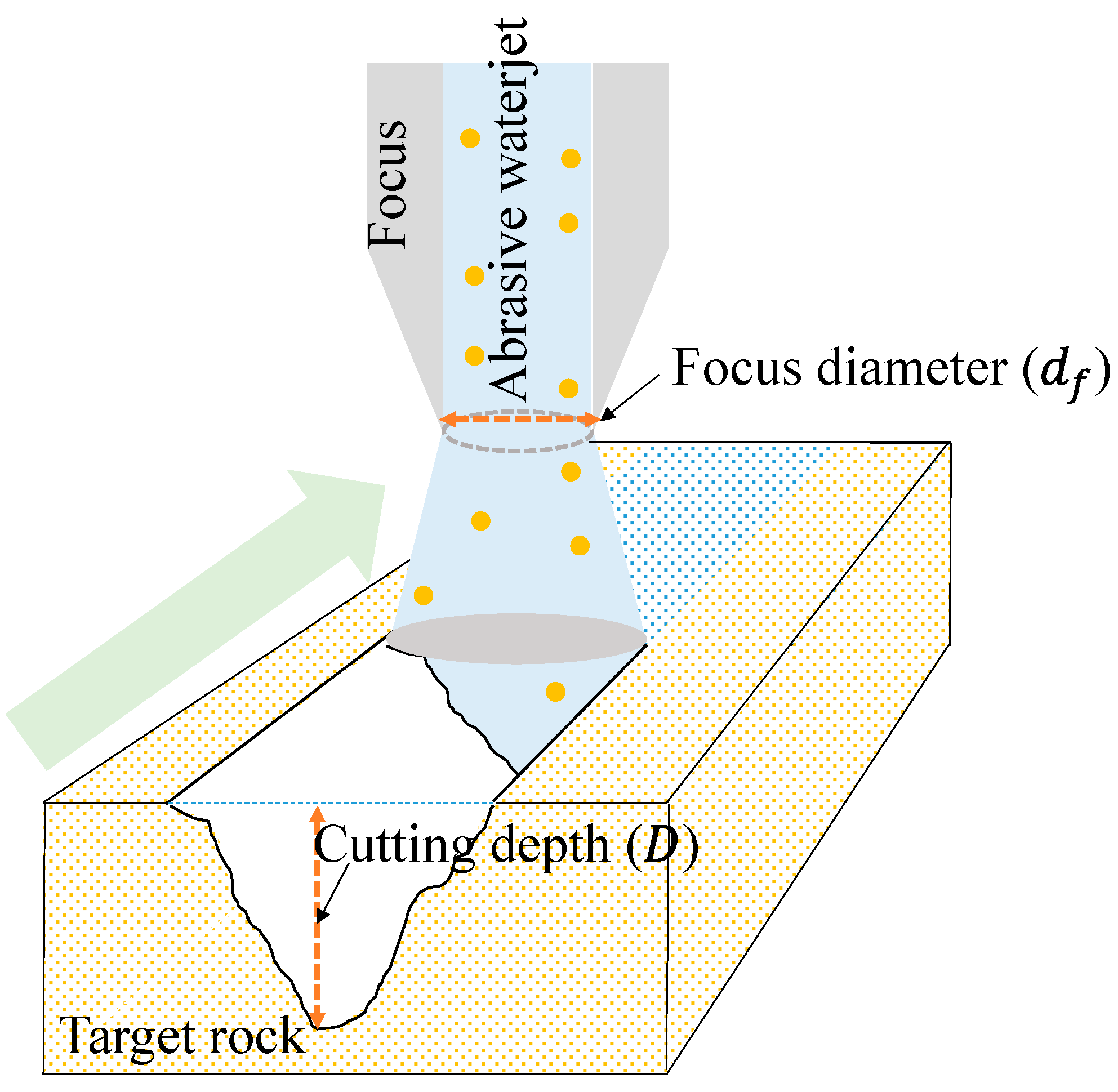


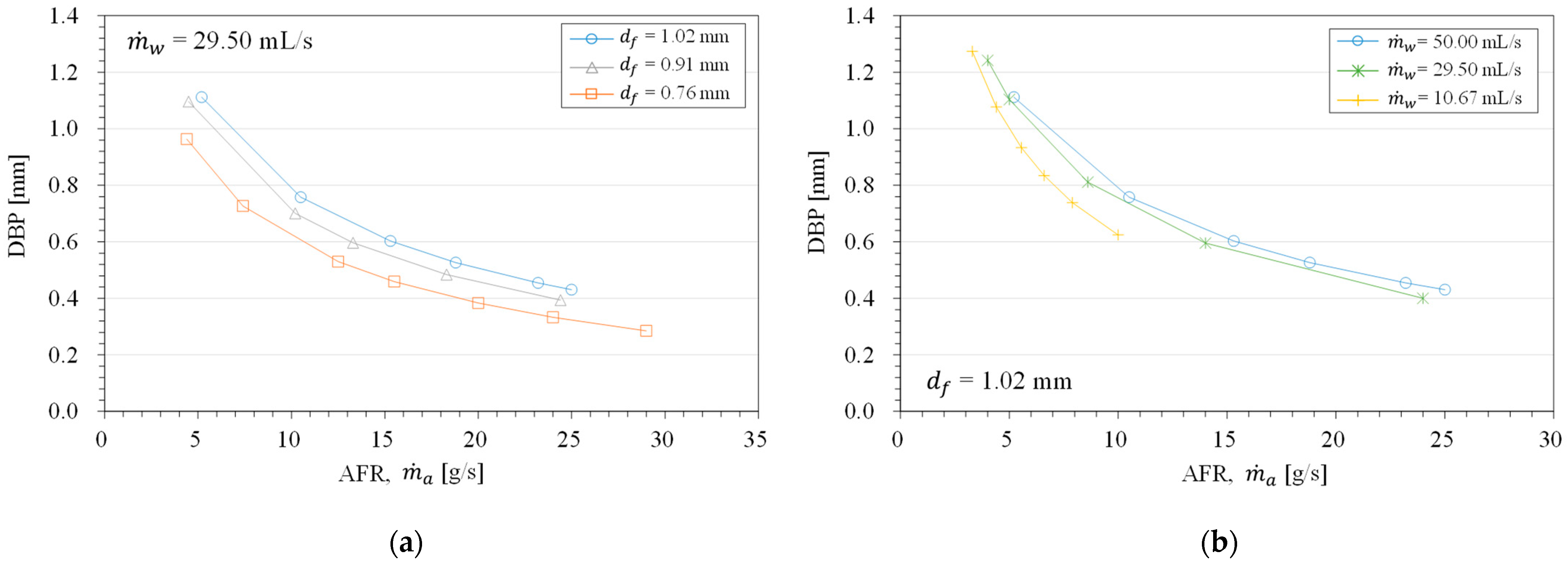
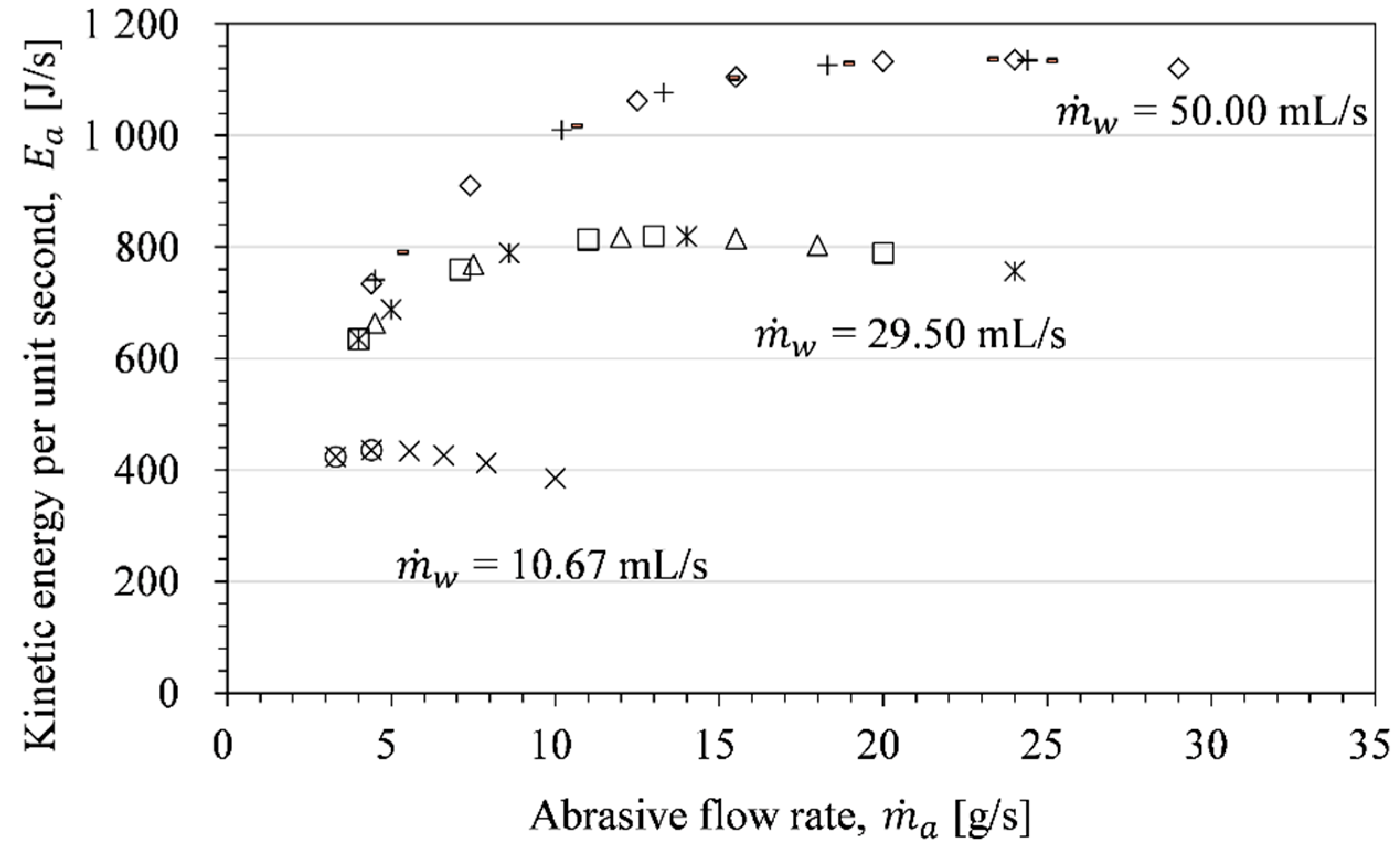

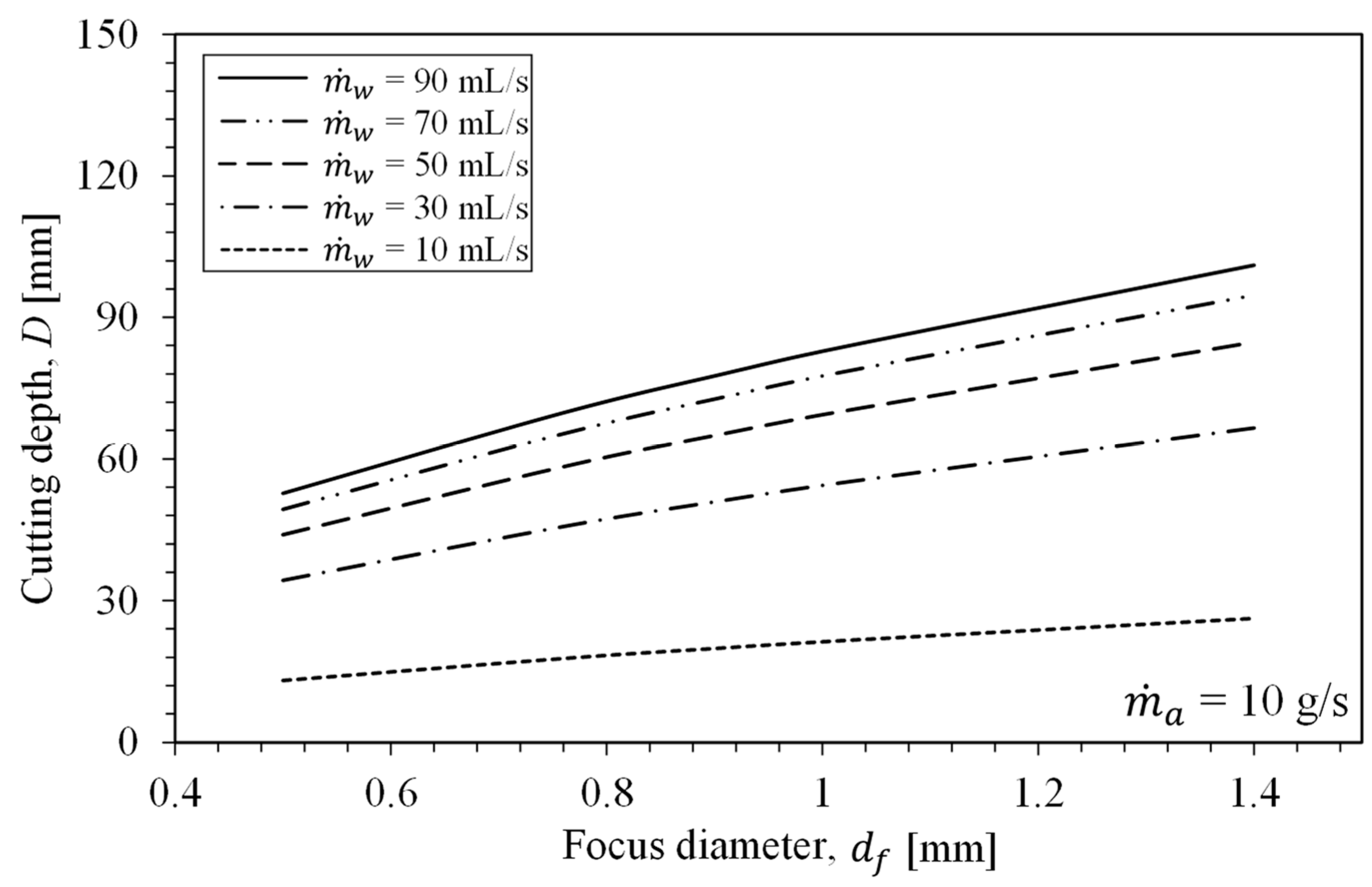
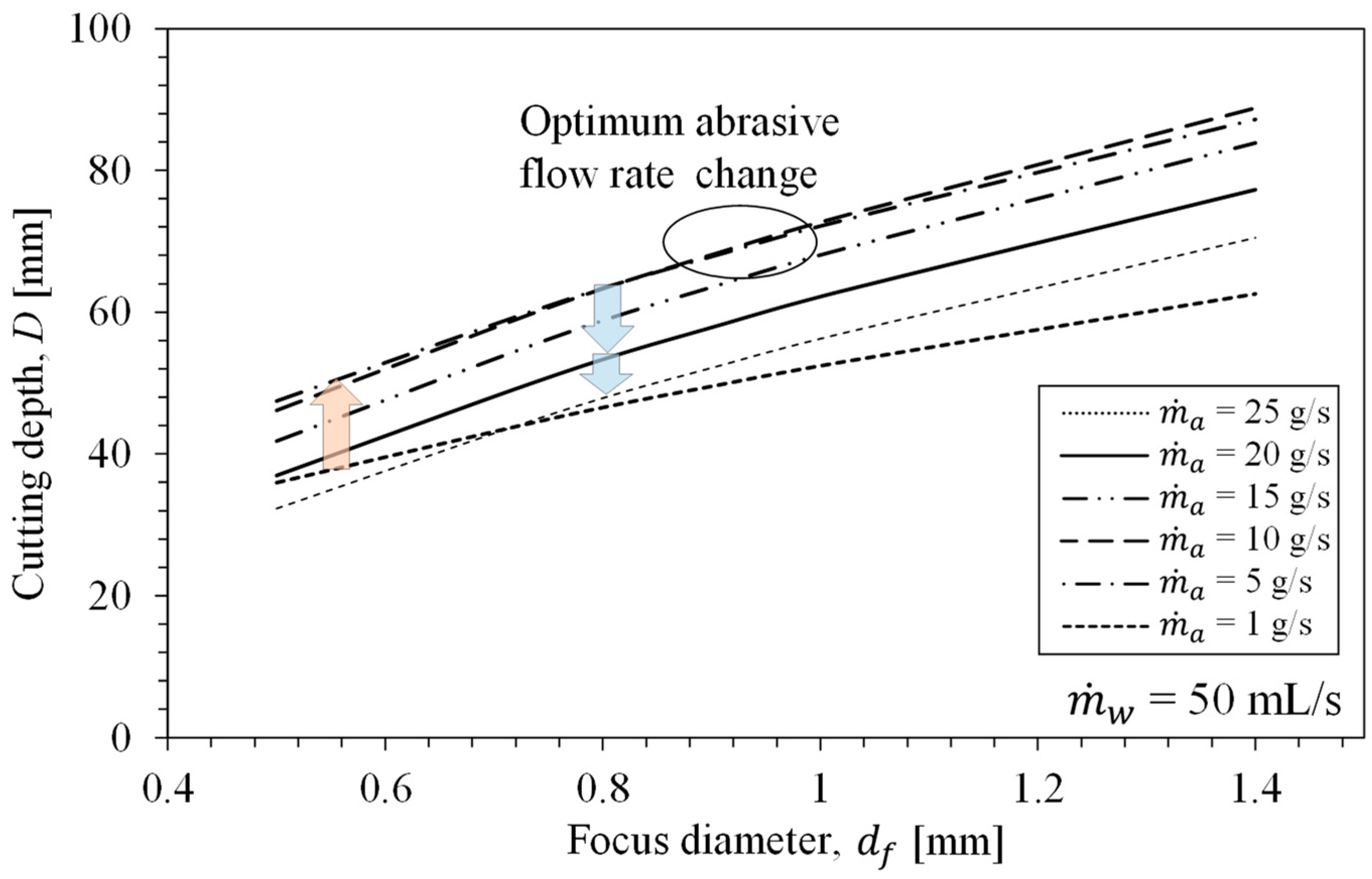
| Variables | Findings | Reference |
|---|---|---|
| Focus geometry | The focus geometry affects the momentum transfer efficiency. | [16] |
| Focus geometry–abrasive flow rate (AFR) | The optimal mixing efficiency is determined in the space in which mixing occurs. | [7] |
| Focus geometry–AFR | The optimum AFR is a function of pressure, and the focus diameter affects the power density. | [22] |
| Flow rate–focus geometry | The economically optimum focus diameter is three times the orifice diameter. | [28] |
| Focus–orifice geometry | The focus diameter affects the surface roughness and determines 98% of the cutting width. | [25] |
| Focus geometry | The surface profile amplitude and surface roughness mainly depend on the focus diameter. | [11] |
| Focus geometry | The focus diameter is the dominant parameter affecting the cutting width and the surface roughness. | [18] |
| Focus geometry–AFR | A larger ratio between the diameters of the focus and abrasive particles reduces the acceleration energy. | [27] |
| Focus and orifice geometry–AFR | The AFR affects the mixing efficiency more strongly than the focus and the water flow rate (WFR). | [5] |
| Orifice Diameter (mm) | 0.15 | 0.254 | 0.33 | |||||
|---|---|---|---|---|---|---|---|---|
| WFR (mL/s) | 10.67 | 29.50 | 50.00 | |||||
| Focus diameter (mm) | 0.76 | 1.02 | 0.76 | 0.91 | 1.02 | 0.76 | 0.91 | 1.02 |
| AFR (g/s) | 3.3 | 3.3 | 4.0 | 4.5 | 4.0 | 4.4 | 4.5 | 5.2 |
| 4.4 | 4.5 | 7.1 | 7.5 | 5.0 | 7.4 | 10.2 | 10.5 | |
| 5.6 | 11.0 | 12.0 | 8.6 | 12.5 | 13.3 | 15.3 | ||
| 6.6 | 13.0 | 15.5 | 14.0 | 20.0 | 1.3 | 18.8 | ||
| 7.9 | 20.0 | 18.0 | 24.0 | 24.0 | 24.4 | 23.2 | ||
| 10.0 | 29.0 | 25.0 | ||||||
| Pump pressure (MPa) | 320 | |||||||
| Abrasive Type | Source | Specific Gravity | Mean Particle Size (mm) |
|---|---|---|---|
| Pyrope garnet Mg3Al2(SiO4)3 | India | 3.79 | 0.18 (Mesh size 80) |
| UCS (MPa) | Shear Strength (MPa) | Tensile Strength (MPa) | Specific Gravity | Absorption Ratio (%) | Shore Hardness |
|---|---|---|---|---|---|
| 236 | 23 | 12 | 2.65 | 0.27 | 114 |
Publisher’s Note: MDPI stays neutral with regard to jurisdictional claims in published maps and institutional affiliations. |
© 2021 by the authors. Licensee MDPI, Basel, Switzerland. This article is an open access article distributed under the terms and conditions of the Creative Commons Attribution (CC BY) license (http://creativecommons.org/licenses/by/4.0/).
Share and Cite
Cha, Y.; Oh, T.-M.; Hwang, H.-J.; Cho, G.-C. Simple Approach for Evaluation of Abrasive Mixing Efficiency for Abrasive Waterjet Rock Cutting. Appl. Sci. 2021, 11, 1543. https://doi.org/10.3390/app11041543
Cha Y, Oh T-M, Hwang H-J, Cho G-C. Simple Approach for Evaluation of Abrasive Mixing Efficiency for Abrasive Waterjet Rock Cutting. Applied Sciences. 2021; 11(4):1543. https://doi.org/10.3390/app11041543
Chicago/Turabian StyleCha, Yohan, Tae-Min Oh, Hyun-Joong Hwang, and Gye-Chun Cho. 2021. "Simple Approach for Evaluation of Abrasive Mixing Efficiency for Abrasive Waterjet Rock Cutting" Applied Sciences 11, no. 4: 1543. https://doi.org/10.3390/app11041543
APA StyleCha, Y., Oh, T.-M., Hwang, H.-J., & Cho, G.-C. (2021). Simple Approach for Evaluation of Abrasive Mixing Efficiency for Abrasive Waterjet Rock Cutting. Applied Sciences, 11(4), 1543. https://doi.org/10.3390/app11041543








